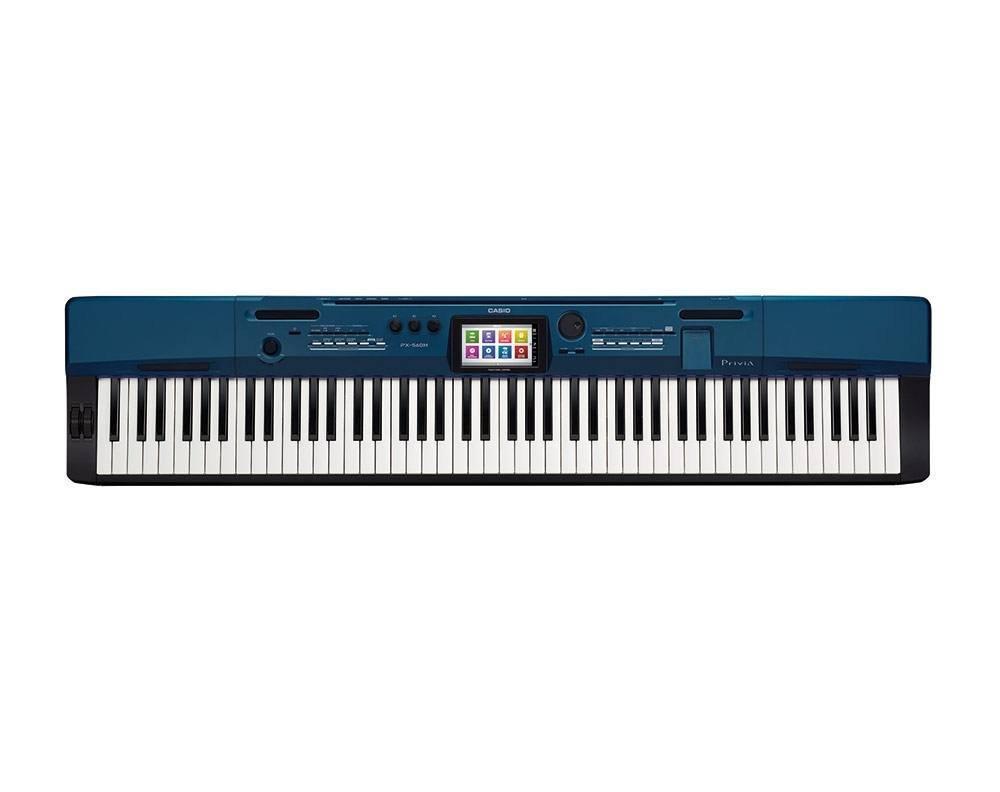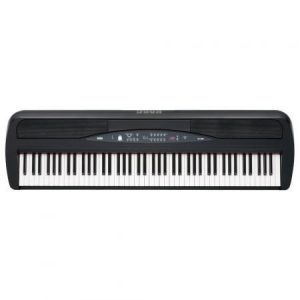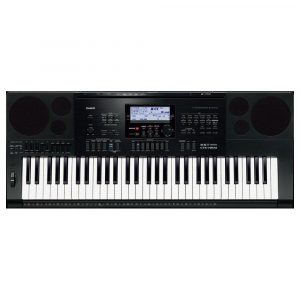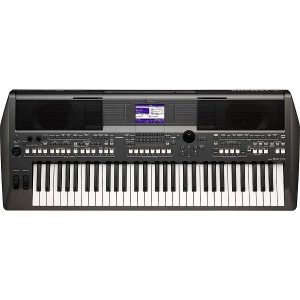Casio PX-560
$907.99
Experience the power of Casio PX-560, the latest digital piano with essential features and modern design, perfect for any musician!
Compare
Description
The Casio PX-560 is a versatile and dynamic keyboard designed to meet the needs of all musicians, whether they are beginners or advanced players. With its impressive range of features and sounds, it’s no surprise that the PX-560 has become a popular choice for those looking for a high-quality keyboard.
One of the most significant features of the PX-560 is its sound engine. The keyboard features Casio’s Multi-dimensional Morphing AiR Sound Source, which delivers an exceptional level of realism and nuance to the instrument’s sound. The sound engine is capable of producing numerous instrument sounds, including grand pianos, electric pianos, and organs, among others. Additionally, the piano samples used in the PX-560 are of high quality, making it sound as if you are playing a real acoustic piano.
The keyboard also features an impressive 256-note polyphony, allowing for complex and dynamic musical arrangements. This means that you don’t need to worry about dropped notes or choppy sounds, even when playing intricate pieces.
The PX-560 also boasts a variety of connectivity options, including MIDI, USB, audio input, and output options. This makes it easy to connect the instrument to other devices such as computers and audio systems, allowing for easy recording and playback of your performances.
Another standout feature of the PX-560 is its touch-sensitive keys. The keyboard features Casio’s Tri-Sensor Scaled Hammer Action II, which accurately mimics the feel and response of a traditional acoustic piano. The hammer action gives the player the necessary control, allowing for effortless and precise playability.
The keyboard has various modes, including layer mode, split mode, and duet mode. In layer mode, you can combine two different sounds, such as a piano and strings, while split mode divides the keyboard into two sections and allows you to play different sounds on each. Duet mode splits the keyboard into two equal sections, allowing two people to play simultaneously, making it an excellent choice for piano lessons and rehearsals.
The PX-560 also features a convenient, easy-to-use interface with a bright, high-resolution color display that shows essential settings and parameters. With its durable construction and compact size, the keyboard is perfect for both home and stage use.
In conclusion, the Casio PX-560 is a highly versatile and dynamic keyboard packed with numerous features that musicians of all skill levels will love. With its high-quality sounds, touch-sensitive keys, and connectivity options, it’s no wonder the PX-560 has become a popular choice for music enthusiasts worldwide.
Casio PX-560 properties
| Product name |
PX-560 |
| Brand |
Casio |
| Type |
Keyboard Instruments |
| Keyboard Instrument |
Keyboard |
| Rotary Controls |
Yes |
Frequently Asked Questions:
What is the minimum number of presets required for a music technician to effectively utilize Casio PX-560's keyboard in their shop?
The minimum number of presets required for a music technician to effectively utilize Casio PX-560's keyboard in their shop would depend on various factors such as the technician's familiarity with the keyboard, the complexity of the tasks they perform, and the types of instruments they repair. However, it is generally recommended that a music technician should have at least three presets for each category of instruments they work on (e. It is also important for the music technician to be able to customize presets according to their needs and preferences.
How do I properly connect Bluetooth MIDI devices to the Casio PX-560 keyboard for wireless transmission of audio data?
Make sure your Bluetooth MIDI device is in pairing mode. This will vary depending on the specific device, but it's usually initiated by pressing and holding a button until the indicator light starts flashing. On the Casio PX-560 keyboard, go to the [Setup] menu and select [MIDI Set]. Select "Bluetooth" from the list of MIDI interfaces and press [ENTER]. The keyboard will search for available Bluetooth devices. When your device appears in the list, select it and press [ENTER]. You'll be prompted to enter a passkey. This is usually a four-digit number that's specific to your device. If you're not sure what the passkey is, consult the user manual for your Bluetooth MIDI device. Once you've entered the correct passkey, press [ENTER]. The Casio PX-560 keyboard will confirm that the connection has been successful and display the name of the connected device. To test the wireless transmission of audio data, play a note on your Bluetooth MIDI device. You should see the corresponding notes light up on the keyboard's LCD screen. If you're not seeing any activity, double-check that both devices are properly paired and within range (usually around 10 meters). To disconnect the Bluetooth MIDI device, go back to the [Setup] menu and select [MIDI Set]. Select "Bluetooth" from the list of MIDI interfaces and press [ENTER]. Then, select "Delete Bluetooth Device" and confirm by pressing [YES]. The keyboard will disconnect from the selected device. To reconnect the Bluetooth MIDI device in the future, simply follow steps 2-7 again.
How does the Super Articulation Voice technology in the Casio PX-560 enhance realism and expression in keyboard performances?
The Super Articulation Voice technology in the Casio PX-560 enhances realism and expression in keyboard performances by providing high-quality, realistic instrument sounds that respond to the player's touch and technique. This technology uses advanced sound processing techniques to simulate the characteristics of each instrument, including their unique playing techniques and tonal qualities. As a result, players can achieve a level of expression and nuance that is truly lifelike and authentic. Whether performing classical piano pieces or more contemporary styles, the Super Articulation Voice technology in the Casio PX-560 allows musicians to express themselves with greater depth and emotion.
How can I optimize the sound quality and functionality of my Casio PX-560 keyboard through advanced settings and software updates?
To optimize the sound quality and functionality of your Casio PX-560 keyboard, here are some steps you can follow:
1. Check for Software Updates:
Casio regularly releases software updates that improve the performance and add new features to their keyboards. To check for updates, connect your PX-560 to a computer using a USB cable and launch Casio's Chordana Play app. Go to the "Settings" menu and select "System Update. Follow the on-screen instructions to download and install the latest software update. Adjust the Sound Settings:
The PX-560 offers a wide range of sounds that you can customize to suit your playing style. To access the sound settings, press the "Function" button and select the "Sound" option. From here, you can adjust various parameters such as volume, pan, reverb, chorus, and EQ. You can also save your favorite sound configurations as user presets for quick access. Use the Super Articulation Voice Technology:
The PX-560's Super Articulation Voice technology allows you to fine-tune the sound characteristics of each instrument. To activate this feature, press the "Function" button and select the "Super Articulation" option. From here, you can choose from a variety of articulations such as key off, string resonance, and body knob response to simulate the natural behavior of acoustic instruments. Utilize the Pedal Sustain Function:
The PX-560's pedal sustain function allows you to sustain notes by pressing the pedal, just like an acoustic piano. To activate this feature, go to the "Settings" menu and select "Pedals. From here, you can adjust the pedal sensitivity and response time to suit your playing style. Customize the Touch Curve:
The PX-560's touch curve determines how the keyboard responds to your touch. To access this feature, press the "Function" button and select the "Touch Curve" option. From here, you can choose from a variety of touch curves or create your own custom settings based on your playing style and preferences. Utilize the Virtual Orchestra:
The PX-560's Virtual Orchestra feature allows you to simulate playing in a full orchestra by layering multiple instruments together. To access this feature, press the "Function" button and select the "Virtual Orchestra" option. From here, you can choose from a variety of orchestral arrangements or create your own custom settings based on your musical vision. Utilize the Chordana Play App:
The Casio Chordana Play app allows you to connect your PX-560 to a computer or mobile device and access a wide range of features, including music score viewing, metronome settings, recording capabilities, and more. To use this app, download it from the App Store or Google Play store and follow the on-screen instructions to connect your keyboard. By following these steps, you can optimize the sound quality and functionality of your Casio PX-560 keyboard through advanced settings and software updates. Remember to always perform tasks to the best of your ability to ensure optimal performance and longevity of your instrument.
Frequenty asked questions about Casio PX-560
How to connect Casio PX-560 to computer?
Casio PX-560 keyboard is a standalone instrument that has its own sound engine. However you can connect it to a PC/Mac computer. It will significantly extend the functions and usability of the instrument. You can use USB-MIDI interface to control co called DAW Software like Ableton Live, Fl Studio, Logic Pro or Cubase to record MIDI notes and command or pure digital audio.
Click here for more informations about Keyboard to PC connectivity
Before you buy Casio PX-560






Ranger –
This is one of the better options for an instrument with a weighted keyboard and a function arranger. For me personally, the best 🙂 An instrument with great possibilities, which takes some time to comprehend, so it is worth buying where the instructions in English are included.
The instrument is definitely worth attention. It looks different in terms of prices depending on the store, but I personally advise you not to buy this type of equipment in foreign stores, because you are often on your own.